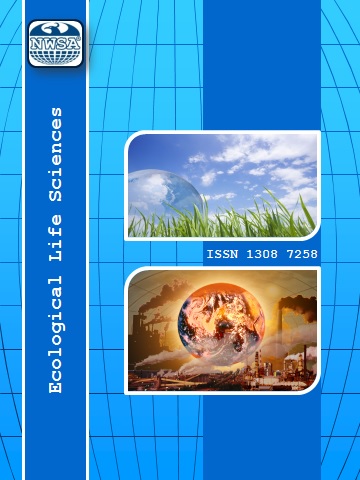References
[1] Gürleyen, N. ve Ustaoğlu, M.R., (2017). Gönen Çayı (Balıkesir-Türkiye durgun sularının zooplankton faunası ve mevsimsel değişimi. Journal of Limnology and Freshwater Fisheries Research, 3(2):79-89.
[2] Kolisko, R., (1974). Plankton Rotifers Biology and Taxonomy. E. Schweizerbartsche Verlagsbuchhandlung (Nageleu. Obermiller), Stuttgart, Germany.
[3] Wetzel, R.G., (1975). Limnology. W.B. Sauders Company, Philadelphia.
[4] Ustaoğlu, M.R., Balık, S., Aygen, C. and Özdemir, D., (1996). Rotifera fauna of Gümüldür Stream (İzmir). E.Ü. Su Ürünleri Fakültesi, Su Ürünleri Dergisi, 13(1-2):163-169, Turkish.
[5] Bekleyen, A., Gökot, B., and Varol, M., (2011) Thirty-four new records and the diversity of the Rotifera in the Turkish part of the Tigris River watershed, with remarks on biogeographically interesting taxa. Scientific Research Essays, 6(30):6270-6284. doi: 10.5897/SRE11.35.
[6] Saler (Emiroğlu), S., Şen, B., and Şen, D., (2000) The seasonal variations of rotifers of Kömürhan region of River Fırat. Su Ürünleri Sempozyumu, Sinop, 385-396.
[7] Saler (Emiroğlu), S. and Şen B., (2001). Rotifers of Zıkkım Stream which flows into Hazar Lake and their seasonal variations. XI. Ulusal Su Ürünleri Sempozyumu, 1:261-271.
[8] Bozkurt, A., Göksu, M.Z.L., Sarıhan, E., and Taşdemir, M., (2002). Rotifera fauna of Asi River (Hatay, Türkiye). Ege Journal of Fisheries and Aquatic Sciences, 19(1-2):63-67.
[9] Bozkurt, A., (2004). Preliminary observation on the zooplankton fauna of some rivers in Mediterranean Region. Turkish Journal of Aquatic Life, 2(3):65-70.
[10] Göksu, M.Z.L., Bozkurt, A., Taşdemir, M., and Sarıhan, E., (2005). Copepoda and Cladocera (Crustacea) fauna of Asi River (Hatay, Türkiye). Ege Journal of Fisheries and Aquatic Sciences, 22(1-2):17-19.
[11] Akbulut (Emir), N. and Yıldız K., (2005). The Rotifera fauna of Euphrates of River Basin (Turkey). Hacettepe Journal Biology and Chemistry, 34:93-105.
[12] Altındağ, A., Buyurgan, Ö., Kaya, M., Özdemir, E., and Dirican, S., (2009). A survey on some physico-chemical parameters and zooplankton structure in Karaman Stream, Antalya, Turkey. Journal of Animal and Veterinary Advances, 8(9):1710-1716.
[13] Bozkurt, A. ve Güven, S.E., (2010) Asi Nehri (Hatay-Türkiye) zooplankton süksesyonu. J FisheriesSciences.com. 4(4):337-353.
[14] http://elaziggezi.com/Sitecontents/page/211.
[15] Koste, W., (1978). Radertiere Mitteleeuropas. 2. Berlin, Germany: Tafelband.
[16] Edmonson, W.T., (1959). Freshwater Biology. 2nd edition. New York, NY, USA: John Wiley and Sons Inc.; London: Chapman and Hall Limited,
[17] Harding, J.P. and Smith, W.A., (1974). A Key to the British Freshwater Cyclopoid and Calanoid Copepods. 2nd edition. Ambleside, UK: Freshwater Biological Association.
[18] Nogrady, T. and Pourriot, R., (1995). Notommatidae and Scaridiidae, Guides to the Identification of the Microinvertebrates of the Continental Waters of the World 8, Dumont, H.J.F. (ed.), SPB Academi Publishing, 1(3):248.
[19] Segers, H., (1995). The Lecanidae (Monogononta). Ghent, Belgium: Ghent University.
[20] Smet, W.H., (1996). Proalidae (Monogonanta), Guides to the Identification of the Microinvertebrates of the Continental Waters of the World 9 (Co. Ed: Dumont, H.J.F.), SPB Academic Publishing, 4, 102.
[21] Smirnov, N.N., (996). Cladocera: The Chydorinae and Sayciinae (Chydoridae) of the World. Guides to the identification of the of the Continental Waters of the World, Amsterdam, the Netherlands: SPB Academic Publishing.
[22] Jorgensen, S., Xu, F.L., and Costanza, R., (2005). Application of indicators for the assessmentof ecosystem health, in Handbook of Ecological Indicators for Assessment of Ecosystem Health, CRC Press, Boca Raton, Ch.2.
[23] Huq, A., Small, E.B., West, P.A., Huq, M.I., Rahman, R., and Colwell, R.R., (1983). Ecological relationships between Vibrio cholerae and planktonic crustacean copepods. Applied Environmental Microbiology, 45:275-283.
[24] Dussart, B., (1969). Les Copépodes des eaux continentales dEurope occidentale. Tome II. Cyclopoides et Biologie. Paris, France: N Boubee et cie.
[25] Saler, S., Eroğlu, M. ve Haykır, H., (2010). Peri Çayı (Tunceli-Türkiye) zooplanktonu. e-Journal of New World Sciences Academy, Ecological Life Sciences, 6(2):14-20.
[26] Saler, S., İpek, N., and Arslan, S., (2011). Zooplankton of Kürk Stream (Elazığ-Turkey). Journal of Fisheries Sciences.com, 5(3):219-255.
[27] Günsel, N. and Akbulut, N., (2012). The Investigation of the zooplanktonic organisms of Delice River and its arms in Kızılırmak River Basin (Turkey). Hacettepe Journal of Biology and Chemistry Special Issue, 309-316.
[28] Güher, H., (2012). The investigation of zooplanktonic organisms (Rotifera, Copepoda, Cladocera) of Meriç River (Turkey). Journal of Animal and Veterinary Advances, 11(24):4673-4677. doi: 10.3923/java.2012.4673.4677.
[29] Özbay, H. and Altındağ, A., (2009). Zooplankton abundance in the River Kars, Northeast Turkey: Impact of environmental variables. African Journal of Biotechnology, 8(21):5814-5818.
[30] İpek, N. and Saler, S., (2013). Zooplankton community structure of Ohi Stream (Elazığ-Turkey). J FisheriesSciences.com, 7(1):83-88.
[31] Bulut, H. ve Saler, S., (2014) Murat Nehrinin (Elazığ-Palu ilçe merkezi sınırları içindeki bölümünde) zooplanktonu ve değişimi. Turkish Journalof Agriculture and Food Science Technology, 2(1):13-17.
[32] Çelik, B., Saler, S., Karakaya, G., Yüce, S., Özbey, N. ve Şeker, T., (2022). Hazar Gölü (Elazığ) zooplanktonunun coğrafik bilgi sistemi ile değerlendirilmesi. Ecological Life Sciences, 17(1):24-35.
 +90(533) 652 66 86
+90(533) 652 66 86 nwsa.akademi@hotmail.com
nwsa.akademi@hotmail.com Fırat Akademi Samsun-Türkiye
Fırat Akademi Samsun-Türkiye
